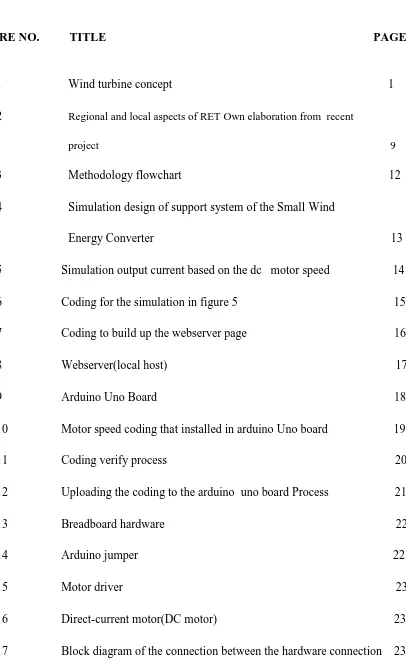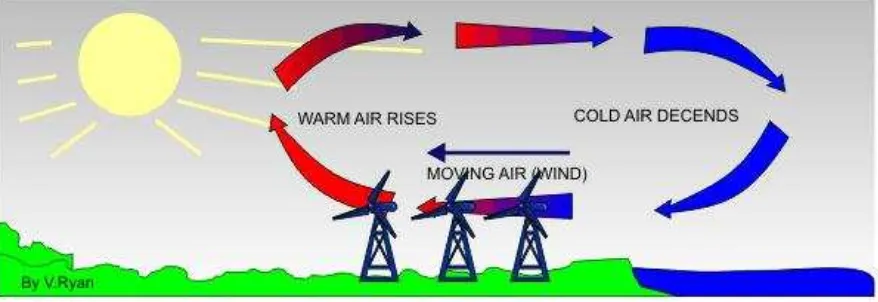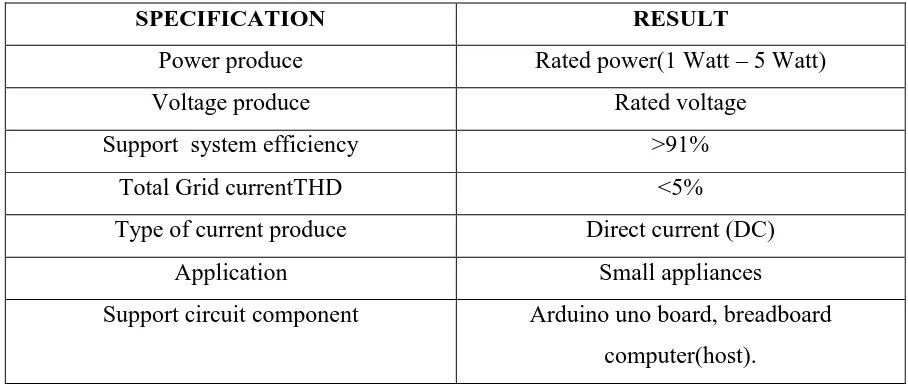UNIVERSITI TEKNIKAL MALAYSIA MELAKA
FINAL YEAR PROJECT BEKU 4792
TITLE : SMALL WIND ENERGY CONVERTER(SWEC)
NAME CHE WAN MUHAMMAD RIDHUAN B CHE WAN RAZALEY
SMALL WIND ENERGY CONVERTER
CHE WAN MUHAMMAD RIDHUAN BIN CHE WAN RAZALEY
A project report submitted in partial fulfillment of the requirement for the award of Bachelor Of Electrical Engineering(Industrial Power)
Faculty of Electrical Engineering
Universiti Teknikal Malaysia Melaka
I declare that the project report entitled “Small Wind Energy Converter” is the results from my own research except as cited in the references.
Signature : ...
Name : Che Wan Muhammad Ridhuan B Che Wan Razaley
I hereby declare that I have read through this report and found that is comply the partial fulfillment for awarding the degree of Bachelor of Electrical Engineering
(Industrial Power)
Signature : ………..………..
Name : WAN MOHD BUKHARI B WAN DAUD
TABLE OF CONTENTS
CHAPTER TITLE PAGE
ACKNOWLEDGEMENT i
ABSTRACT ii
1 INTRODUCTION 1.1 Project Background 1
1.2 Problem Statement 2
1.3 Objectives 2
1.4 Project Scopes 2
1.5 Significant Of The Study 3
1.6 Thesis Of Line 4
2 LITERATURE REVIEW 2.1 Introduction 5
2.2 Wind Speed Prediction 5
2.3 Power Curve A Single Wind Turbine 6
2.4 Social And Economic Benefit Of Wind Energy Technology 7
3 METHODOLOGY 3.1 Introduction 11
3.2 Flow of project 11
3.3 Simulation design circuit of support system of the Small 3.4 Wind Energy Converter 13
3.10 Experimental For The Whole System Of Small
Wind Energy Converter 29
4 RESULT AND DISCUSSION 4.1 Introduction 30
4.2 Simulation result of main circuit of the Small Wind Energy Conveter 30
4.3 Experiment result for the support system of the Small Wind Energy Converter 31
4.4 Simulation result for design circuit to determine the current output based on the motor speed 32
4.5 Results For Efficiency Of The Support System 33
4.6 Discussion 34
5 CONCLUSION AND FUTURE WORKS 5.1 Introduction 35
5.2 Conclusion 35
5.3 Recommendation 36
5.4 Awards 36
REFERENCES 37
LIST OF TABLE
TABLE NO. TITLE PAGE
1 Scopes of work 3
2 Description of data type 6
3 Classification and characteristics of employment in RET 10
4 Simulation results for support system Small Wind Energy Conveter 30
5 Measurement from the support system 32
6 Result for current produce based on the dc motor speed 32
7 Efficiency Of The Support System 33
LIST OF FIGURE
FIGURE NO. TITLE PAGE
1 Wind turbine concept 1
2 Regional and local aspects of RET Own elaboration from recent project 9
3 Methodology flowchart 12
4 Simulation design of support system of the Small Wind Energy Converter 13
5 Simulation output current based on the dc motor speed 14
6 Coding for the simulation in figure 5 15
7 Coding to build up the webserver page 16
8 Webserver(local host) 17
9 Arduino Uno Board 18
10 Motor speed coding that installed in arduino Uno board 19
11 Coding verify process 20
12 Uploading the coding to the arduino uno board Process 21
13 Breadboard hardware 22
14 Arduino jumper 22
15 Motor driver 23
16 Direct-current motor(DC motor) 23
18 Final connection between all the component in the support system 24
19 A to B cable 24
20 Python configuration 25
21 Coding file setup in the webserver directory 26
22 Block diagram for a support system 27
23 Experimental design for the support system 28
24 Experimental design for the whole system 29
ACKNOWLEDGEMENT
In the name of Allah, the Most Beneficent and The Most Merciful. It is a deepest sense gratitude of the Almighty that give me strengh and ability to complete this Final Year Project report.
A special gratitude i give to my final year project supervisor , Mr. Wan Mohd Bukhari B Wan Daud , whose give me a valuable guidance and support and helped me to coordinate
my project especially in writing this report.
A special thanks goes to my family for their moral support to me in the process to complete this project. Besides that, i would also like to acknowledge with much appreciation to all my friends who help me in order to complete my Final Year Project.
ABSTRACT
ABSTRAK
Kapasiti kuasa angin telah mengalami pertumbuhan yang besar dalam satu dekad yang lalu, terima kasih kepada faedah kuasa alam sekitar iaitu angin, kemajuan teknologi dan insentif kerajaan. Penggunaan tenaga angin kecil sebagai sumber untuk menghasilkan tenaga elektrik menjadi penting pada masa kini. Kajian ini membentangkan perkembangan terkini dalam sistem penukaran tenaga angin kecil, faedah dari aspek sosial dan kepada alam sekitar. Laporan ini juga menunjukkan kajian semula tentang isu-isu sambungan sumber diedarkan termasuklah sumber angin dan sumber elektrik. Kesuluruhan laporan ini membentangkan tentang prototaip penukaran tenaga angin kecil. Reka bentuk prototaip ini direkabentuk menggunakan motor arus terus sebagai turbin angin yang akan menghasilkan tenaga elektrik dengan menggunakan konsep motor arus terus. Keluaran yang digunakan dalam prototaip ini adalah beban dan paparan LCD (liquid crsytal display). Tujuan penggunaan LCD sebagai keluaran adalah untuk menunjukkan tahap voltan di dalam penyimpanan kuasa dan untuk merekodkan kenaikan tahap voltan apabila turbin berpusing. Tambahan lagi, litar sokongan direka dengan menggunakan papan arduino uno R3 yang akan berkomunikasi dengan graphical unit interface(GUI) di dalam komputer untuk mengawal motor arus terus jika tiada sumber utama iaitu angin. Keputusan yang direkodkan menunjukkan bahawa kecekapan sistem sokongan ialah antara 91 peratus dan
CHAPTER 1
INTRODUCTION
1.1Project Background
[image:13.595.88.527.455.606.2]Wind power is generated by moving air. As the sun heats the land, the air above also warms and rises. Cold air then replaces the rising air. This creates the winds that we feel most days of the year. The diagram below shows how this ‘system’ works. Air tends to warm at a faster rate over land because the land retains its heat. Over the sea the air warms more slowly as heated by the sun and slowly cooled by the cold water. If you visit the seaside or coastal area you will probably find that the weather is more breezy or windy than inland. This is because the warm air rises over the land and cold air over the sea replaces it.
support for our life. Large wind turbine technology is already one of the larger future energy supplies and small wind turbines have a big potential. What is needed for a
common use of wind are turbines that meet a specification that is flexible enough for general application and be possible to mount almost everywhere and plug-in to the grid. Wind turbines on the market are often larger, mounted on high towers and need plenty of space around them for safety and efficiency. The only way is therefore to specify flexible wind turbines which need a small space, cheap, low risk to install and high efficiency.
1.2Problem Statement
Due to the wind is one of the renewable energy that have a high potiential to be developed as a source of electrical energy. In addition, wind energy can reduce greenhouse effect when its compared with other sources of electricity such as hydro, coal, gas plant or other renewable energy that can be use to generate an electrical energy. This project about the development a small wind energy converter consists of DC motor as a wind turbine, lcd display(to measure a voltage in the power storage) and the arduino uno board that located in a support curcuit. This project has been devolep because the wind energy has a high potential and the small wind energy require a the detail development because it has high potential to be developed in our country.
1.3Objective
The objective of this project is to build a small wind turbine which produce a rated power(1 Watt – 5 Watt) and to built a support systems using arduino controller for
emergency situation (if there is zero wind).
1.4Project Scopes
Table 1 : Scopes of work
SPECIFICATION RESULT
Power produce Rated power(1 Watt – 5 Watt)
Voltage produce Rated voltage
Support system efficiency >91%
Total Grid currentTHD <5%
Type of current produce Direct current (DC)
Application Small appliances
Support circuit component Arduino uno board, breadboard computer(host).
1.5Significant Of The Study
The overall study is about how to build the small wind energy converter with the support circuit that will make sure there are always has a supply from the turbine to the power storage. In this study the battery is used in the prototype small wind energy converter as a power storage. The support system was build using the arduino board and the computer as a host to control the input level to the turbine. In case there are no primary source to rotate the turbine, the input level speed for turbine will be control by the webserver that located in the computer and then the speed will be sent to the arduino board. Then , the arduino board will control the speed of turbine in order to generate electricity at the output terminal. Althought the support system use a small power to run the circuit system but the support system will provide a huge power to the turbine and it will produce a large power at the power storageThis systems has a high
1.6Thesis Out Line
There are five chapters in this report that consists of introduction, literature review,
CHAPTER 2
LITERATURE REVIEW
2.1 Introduction
Wind is one of the renewable energy that can be used to produce electricity. The using of wind as a source to generate a electric energy become more significant nowadays. There are a lot of the benefit by using a wind as a main source to produce electric. This chapter will study the recent development on small wind energy converter , their social and environment benefit and interconnection issues of distributed resources including wind power with electric power systems.
2.2 Wind Speed Prediction
A.Kusiak, et.al [1] agree that one of the important aspect in handling the wind turbine energy converter is wind speed prediction. Wind speed is an important thing that must be consider because the power produced by the wind converter is totally depend on the wind speed. Determining the power generated by wind turbine at future times is important for unit commitment planning and maintenance scheduling. Wind speed must be predicted to
2.3 Power Curve Of A Single Wind Turbine
Wind speed is the most influential factor on the power generated by a wind turbine. The theoritical power [2] that can be extracted from the wind is expresses by equation (1) :
P=0.5πR²Cp(λ,β)V³ (1)
Where P is the theoritical power captured by the rotor of a wind turbine, p is the air density, R is the radius of the rotor (blade’s length) determining its sweeping area, Cp(λ,β) is the power coefficient and V is the wind speed. The air density p at the turbine’s hub height remains usually constant over a long-time horizon. Thus the most important operation parameters impacting the generated power area Cp(λ,β) and V. The power coefficient indicates the efficiency of a turbine capturing the wind energy and its is optimized by the control system[3].
To analyze the perfomance of wind turbines, the SCADA data collected at a wind farm has been used. Table 2 shows data set 1 with the beginning time stamp “1/1/07 12:00AM” and ending time stamp “1/31/07 11:50 PM”. Data set 1was divided into two data subsets, data set 2 and data set 3. Data set 2 contains 3476 data points and was used to develop a data-driven model estimating the power curve. Data set 3 inlcudes 871 data points and was
[image:18.595.81.532.546.696.2]used to test perfomance of the model learned from data 2.
Table 2 : Description of the data set
Data Set Start Time Stamp End Time Stamp Description
1 1/1/07 12:00 AM 1/31/07 11:50 PM Total Data Set : 4347 Observation.
2 1/1/07 12:00 AM 1/25/07 6:20 PM Training Data Set : 3476 Observation.
3 1/25/07 6.30 PM 1/31/06 11:50 PM Test Data Set : 871 Observation.
power gain. The data points in region away from the logitic-curve region usually represent an anomaly leading to, for example, decrease perfomance[3].
2.4 Social And Economic Benefit Of Wind Energy Technology
Wind benefits brought by ( Resources, Energy and Tourism) RET have been extensively evaluated, as well as economic costs and its contribution to energy security. However, a thorough discussion of the socio-economic impacts of these technologies is still limited. This discussion becomes even more important in periods of low economic growth [4,5]. One of the the social and economic benefits are technological innovation and industrial development distributed generation and universal access to energy regional and local development, especially in rural areas and job creation. According to Laitner et al. [6], assessments on the performance of climate and energy policies usually do not take into account the dynamics of technological innovation, and often associate reductions in energy consumption and GHG emissions with economic losses.
Frankhauser et al. [4] argue that technological innovation and the creation of new opportunities for investments and economic growth are both consequences of climate policies. Technological change and innovation, in the long term, increase the demand for labour and skills. The writer also emphasize the role of good policies aimed at motivating technological innovation. In this context, the pioneers in the development of clean
technologies have the potential for regional leadership. The author also use the case of Germany, which today stands out as a leader in the export of clean technologies. RET are
meet the development goals without going through the intensity of fossil fuel consumption that marked the growth in developed countries [11]. The convergence between the fields of
energy planning and economic development is present in various energy policies. Such convergence is known as energy-based economic development, whose main goals are to increase self-sufficiency and energy diversification, contributing to economic and industrial growth and development; to increase entrepreneurship and encourage technological innovation; and to increase the level of employment and training [12]. The presence of renewable energy projects in rural areas, especially those characterized by low economic development, can bring benefits to the community. High unemployment rates, lack of alternative economic development, and high rates of migration of economically active population, offer a worthwhile environment for investment in RET. Compared to traditional power plants, renewable energy units are often smaller, modular and decentralized and, therefore, they are often located in rural areas with low population density. Due to this feature, the construction of these plants demands high amounts of labour, and creates the potential for training and employment of rural populations in several locations [13].
Besides generating temporary jobs in construction, there are fewer but long lasting job opportunities in the operation and maintenance (O&M) of power plants. The deployment of renewable energy projects offers an alternative or complement to agricultural activities,
development benefits brought by investment inrenewable energy sources is illustrated in Figure 2.
Jobs generated by wind power and other RET can be grouped into three part according
to their location, temporal nature, and level of expertise. The first part refers to jobs
[image:22.595.77.534.297.468.2]generated in technological development, and includes R&D and equipment manufacturing. The second part refers to jobs in installation and decommissioning of plants, and comprises planning, project management, transportation and power plant construction and decommissioning. The third part is operation and maintenance (O&M), and includes, besides the actual O&M of the plant, energy distribution and commercialization. The characteristics are summarized in Table 3.
Table 3 : Classification and characteristics of employment in RET [18]
Category Volume Of Job Creation
Location Temporal nature
Specialization level demanded
Technological devolepment
Medium From non-local to local
Stable Very high
Installation High From local to non-local
Temporary High
Operation and maintenance
Low Local Stable Medium
CHAPTER 3
METHODOLOGY
3.1 Introduction
In this chapter, a brief discussion on methodology approach performed in the study. It will be divided into several sections to give a detail explanation about the methodology of the development of small wind energy converter.
3.2 Flow Of Project
Figure 3 : Methodology flowchart Title Selection
Literature review
Prepare an inital proposal
Simulation Design of support system of the Small Wind
Converter Energy using MATLAB
Result and analysis
Report for Final Year Project ARDUINO/JAVA SCRIPT/PHP/PYTHON
coding development in Arduino application Experimental Design for a support system of Small Wind




![Figure 2: Regional and local aspects of RET. Own elaboration from [7,12,15,18]](https://thumb-ap.123doks.com/thumbv2/123dok/512959.58333/21.595.146.463.482.743/figure-regional-local-aspects-ret-elaboration.webp)
![Table 3 : Classification and characteristics of employment in RET [18]](https://thumb-ap.123doks.com/thumbv2/123dok/512959.58333/22.595.77.534.297.468/table-classification-characteristics-employment-ret.webp)
